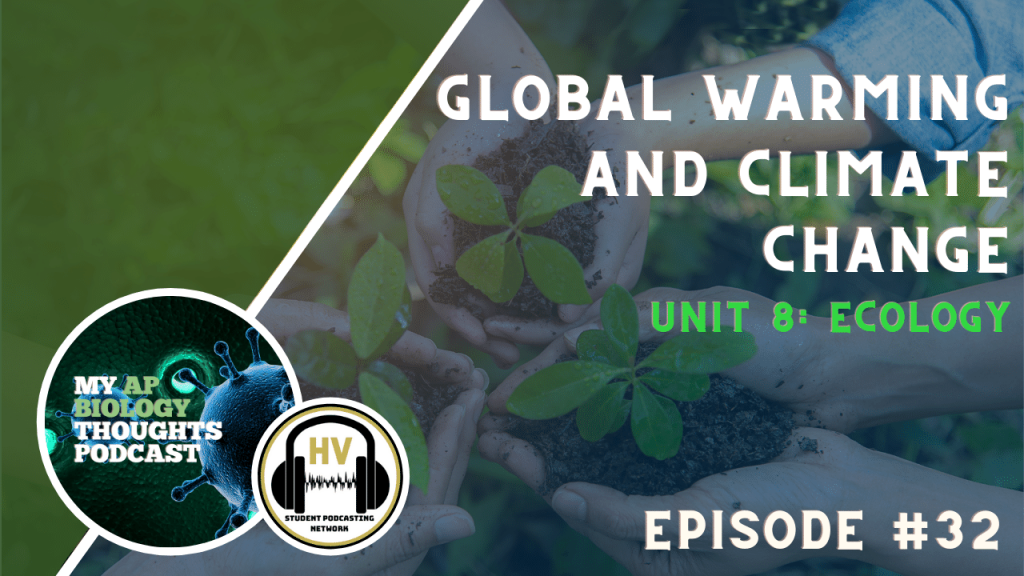Global Warming and Climate Change

My AP Biology Thoughts
Unit 8 Episode #32
Welcome to My AP Biology Thoughts podcast, my name is Sid and I am your host for episode 32 Unit 8 Ecology: Global Warming and Climate Change. Today we will be discussing Global warming, climate change and how they affect environments and species.
Segment 1: Introduction to Global Warming and Climate Change
- Global warming is the increase in temperature through many years largely due to the effects of greenhouse gases being released into the atmosphere. Though they are similar, climate change is slightly different from global warming. Climate change refers to the changing climate over a period of time. This means changes in precipitation, temperature, and wind patterns. Climate change and global warming is mostly because of human activity when they release carbon dioxide, pollutants, and greenhouse gases into the atmosphere. These gases absorb sunlight and radiation that bounce off of the Earth’s surface and increase the global temperature. Global warming then causes other climate change such as increased precipitation. When the global temperature is increased, this allows more evaporation to occur and the atmosphere to hold more moisture. Also, as arctic regions melt, water levels rise promoting even more evaporation. As a result, precipitation becomes much more intense in many regions. The increase in temperature also causes changes in wind patterns. As temperatures increase in some regions, winds become slower.
Segment 2: Example of Global Warming and Climate Change
- Global warming and climate change has disastrous effects on the environment and many species. Global warming affects some regions more directly than others. For example, arctic regions like Greenland are heavily affected. In Greenland, as the air and water temperature increase, there are disastrous effects like losing sea ice, the melting of the ice sheet, and habitat destruction of species that live there. On average, Greenland loses an average of 234 billion tons of ice mass per year. This is a drastic change because in the 1990’s this was only 25 billion tons lost per year. This change in Greenland affects species like polar bears. Polar bears rely on sea ice in order to hunt seals. Because the sea ice has been so drastically reduced, polar bears have had to adapt to this change but have been struggling to do so. It’s now predicted that the populations of polar bears will drop by 30% in the upcoming decades. This would cause the total number of polar bears to become under 9,000. Many other species are also affected. To start, Moose populations are heavily affected by climate change. As temperatures rise, winter ticks, parasites that often feed on the blood of moose, increase in population. As the population of winter ticks increase, a higher number of them end up on moose. There can be up to tens of thousands of these ticks on one moose. When there are many ticks on one moose, the moose often die especially when they are young. Another species affected are salmon. Salmon require cold and fast flowing rivers. As temperatures increase, the water temperature increases and the flow of rivers can change. This affects how they interact with their environment. Also, similar to the moose, the parasites that feed off of salmon increase in population which causes them to die off at higher rates. Another species that is affected are the sea turtles. When the temperatures increase this causes sea levels to rise, increased precipitations, and more extreme storms. This causes nesting and foraging sites to become unsuitable and makes it harder for the sea turtles to survive. For one last example, giant pandas are another animal heavily affected by global warming and climate change. As temperatures increase, the main food source for pandas, bamboos, are becoming wiped out. Because pandas are losing their main food source, they are dying off as well.
Segment 3: Digging Deeper Global Warming and Climate Change
- Global warming has direct effects on ecology. Ecology refers to organisms, their populations, and how they interact with their environment. Global warming and climate change directly affects all levels of ecology from individual organisms, populations, communities, and ecosystems across the Earth. Global warming can affect entire ecosystems as temperatures increase, storms become more intense, arctic regions melt, and sea levels rise. This of course would affect the way organisms interact with their environment.
Thank you for listening to this episode of My AP Biology Thoughts. For more student-ran podcasts and digital content, make sure that you visit www.hvspn.com. See you next time!
Music Credits:
- “Ice Flow” Kevin MacLeod (incompetech.com)
- Licensed under Creative Commons: By Attribution 4.0 License
- http://creativecommons.org/licenses/by/4.0/
Subscribe to our Podcast
- Apple Podcasts
- Spotify
- Google Podcasts
- Stitcher
- YouTube
Connect with us on Social Media
Twitter @thehvspn

